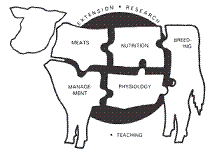Animal Science, Department of
Date of this Version
2021
Citation
Published in 2021 Nebraska Beef Cattle Report, University of Nebraska Extension Publication MP110
Abstract
In nearly every production environment, there are opportunities to capture profits if waste streams can be further processed or enhanced to create “value added” products. Animal feeding operations in Nebraska generate significant amounts of manure that are considered as a “waste” product. Additionally, Eastern red cedar (Juniperus virginiana) encroachment into grazing land has become an economic and ecological threat, reducing forage production, fragmenting wildlife habitats, and increasing the risk and severity of wild fires. Value- added uses for cedar woodchips are being sought by the Nebraska Forest Service and other agencies to promote tree management by landowners. Using manure and cedar mulch individually or in combination as soil amendments on agricultural crop land was proposed by farmers in the Middle Niobrara Natural Resource District to assess their impacts on soil health and crop productivity. On- farm research studies were initiated during 2019 at four locations across the state of Nebraska and two more sites were added in 2020. The goal is to document and demonstrate the effects of land applied manure and cedar mulch on agronomic, economic and soil health variables in corn fields under different agro-climatic conditions. Results from the 2019 cropping season indicate that pre- plant applications of beef manure can make significant contributions of nitrogen (N), phosphorus (P) and potassium (K) and K in crop fields without compromising yield, constituting a reliable resource to replace inorganic fertilizers. Depending on initial soil quality, manure also increased soil organic matter (SOM) concentration, pH, and electrical conductivity (EC). Surface applications of cedar mulch did not promote soil acidification or N immobilization, although it induced soil nitrate reduction in top soil layers when incorporated after crop harvest at one research site.
Included in
Large or Food Animal and Equine Medicine Commons, Meat Science Commons, Veterinary Preventive Medicine, Epidemiology, and Public Health Commons



Comments
Copyright © 2020 The Board of Regents of the University of Nebraska.